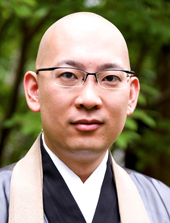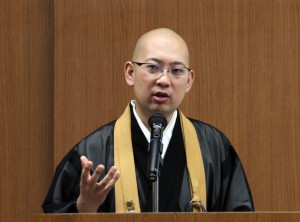This event now concluded. Report available here.
- *This event has finished. A report on this lecture is available.
- Lecturer: Matsuyama Daiko (Deputy Priest, Taizoin Zen Buddhist Temple, Kyoto)
- Date: Saturday, October 1, 2016, 1:30-3:00 pm
- Venue: Lecture Hall, International House of Japan
- Language: Only available in Japanese (without English interpretation)
- Admission: Free (reservations required)

 Born in 1978 in Kyoto, Mr. Matsuyama obtained his Master’s degree in Agriculture and Life Sciences from the University of Tokyo. After three and half years of training at Heirin-ji Temple, Niiza, he became the deputy priest of Taizoin Temple in 2007. Mr. Matsuyama is acclaimed for organizing intercultural activities such as Zen experience tours for foreign visitors and talks at embassies in Japan and at the Foreign Correspondents’ Club. In May 2009, he was elected as a Japan Tourism Agency’s Ambassador for its “Visit Japan” Campaign. He has been a member of Kyoto’s Ambassadors for Tourism since 2011, and was listed as one of “The Top 100 People of the New Generation 2016” in Nikkei Business. As a young representative of the Zen Sect in Japan, Mr. Matsuyama has interacted with many religious leaders, such as having an audience with the Roman Catholic Pope and conversing with the 14th Dalai Lama. He also participated in the Davos World Economic Forum in 2014, and continues to work actively beyond national and religious borders. He is the author of the book, Forget What’s Important First: 30 Zen Teachings for the Wavering Soul (Sekai Bunka Publishing, 2014).
Born in 1978 in Kyoto, Mr. Matsuyama obtained his Master’s degree in Agriculture and Life Sciences from the University of Tokyo. After three and half years of training at Heirin-ji Temple, Niiza, he became the deputy priest of Taizoin Temple in 2007. Mr. Matsuyama is acclaimed for organizing intercultural activities such as Zen experience tours for foreign visitors and talks at embassies in Japan and at the Foreign Correspondents’ Club. In May 2009, he was elected as a Japan Tourism Agency’s Ambassador for its “Visit Japan” Campaign. He has been a member of Kyoto’s Ambassadors for Tourism since 2011, and was listed as one of “The Top 100 People of the New Generation 2016” in Nikkei Business. As a young representative of the Zen Sect in Japan, Mr. Matsuyama has interacted with many religious leaders, such as having an audience with the Roman Catholic Pope and conversing with the 14th Dalai Lama. He also participated in the Davos World Economic Forum in 2014, and continues to work actively beyond national and religious borders. He is the author of the book, Forget What’s Important First: 30 Zen Teachings for the Wavering Soul (Sekai Bunka Publishing, 2014).
What is the “Nitobe Leadership Program”?
Report
Myoshinji Taizoin is a small, ancient Buddhist temple in Kyoto that has drawn visitors from around the world who want to experience zazen meditation and Japanese culture. The deputy priest at Myoshinji Taizoin, Matsuyama Daiko, has been the driving force behind organizing a number of such initaitives at the prestigious temple. Matsuyama has been involved in not only interfaith exchanges but also a broad range of activities that go beyond the framework of religion, such as his participation in the World Economic Forum. And during his talk he discussed the religious outlook of the Japanese people and the relation between contemporary religion and society.
Matsuyama was born the eldest son of the head priest of Myoshinji Taizoin. Although he was brought up in an environment where it was predetermined that he would one day take over the temple, his parents, rather surprisingly, decided to send him to a Catholic junior- and senior high school. As a university student he visited Ireland, and some of the local people he met there were taken aback that someone raised in a Buddhist family would be sent to a Catholic school. It is not unusual in Japan, however, for people to enjoy Christmas cake but at the same time to hear the bells being rung at Buddhist temples on Omisoka (New Year’s Eve) and then pay a visit to a Shinto shrine on the following day. This eclectic approach might seem strange from the perspective of other countries, but Matsuyama believes it is a great asset of Japanese culture.

At a time when the international community faces conflict and intolerance, Matsuyama believes that Japanese people should confidently convey to other people their flexible attitude toward religion, reflected in the Japanese Buddhist concept of the non-duality of things, or funi in Japanese. As one example of what he would like to convey, Matsumyama points to the radio show he particpated in named “Eight O’Clock! Gods and Buddha,” where clergy of different religious denominations took calls from listeners and gave advice regarding their problems. Another initiative he pointed to was the Inter Faith Ekiden marathon, where runners from different religious backrounds competed together on the same team.
Just prior to his lecture, Matsuyama attended a conference of world religious leaders at Assisi in Italy. He said that there was far less local media coverage of the event than in the past, which gave him a keen sense of how Europeans are drifting away from religion. At the summit, Pope Francis stressed that priests, monks, imams, and other religious figures need to reach out to others, and that it is important to share their thoughts using their own words, rather than preaching religious dogma, when approaching those who are not interested in religion. In response to the comments by the Pope, Matsuyama pointed out that it is necessary for religious figures to make more effort in building up and putting into practice their own religious “experience.”
Matsuyama has been emphasizing the need not only for interfaith dialogue, but also for interaction with scientists. His motivation for this approach stems from the 2011 nuclear disaster in Fukushima. During his talk, he said with regret that religious persons should have made more effort to study science. “It is too late,” he added, “if we wait until a technology has already been created and taken root in society.” In recent years, there has been prominent technological innovation in the germline field, such as iPS cells. Although Matsuyama recognizes the amazing aspects of these cutting-edge technologies, he stressed the difference between “what can be done” and “what we choose to do.” He pointed to this as one example of an area where religious people and society at large can think together and coexist.